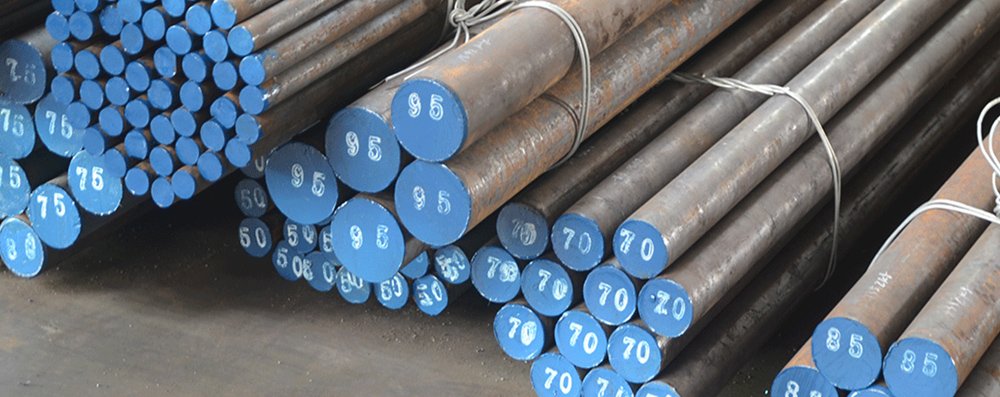Introduction
HCHCR (High Carbon High Chromium) steel is a versatile tool steel grade known for its exceptional wear resistance, hardness, and dimensional stability. It is often associated with the D2 steel category and is used extensively in the production of tools and dies subjected to heavy abrasion and wear. With a combination of high carbon and chromium content, HCHCR delivers outstanding hardenability, corrosion resistance (to a limited extent), and edge retention, making it ideal for various demanding industrial applications.
Properties of the Grade:
- High wear resistance
- High surface hardness
- Good dimensional stability during heat treatment
- Excellent compressive strength
- Moderate corrosion resistance
- High edge retention
- Good toughness for a high-carbon alloy
- Deep hardening response due to air-hardening capabilities
Uses/Applications:
HCHCR steel is widely utilized in the manufacturing of tools, dies, and components that require high hardness and wear resistance, including:
- Shear blades
- Forming dies
- Thread rolling dies
- Wire drawing dies
- Extrusion tools
- Blank and forming dies
- Cold work punches
- Gauges
- Industrial knives
- Coining tools
Chemical Composition:
| Element | Content (%) |
| Carbon (C) | 1.40 – 1.60 |
| Chromium (Cr) | 11.00 – 13.00 |
| Molybdenum (Mo) | 0.70 – 1.00 |
| Vanadium (V) | 0.70 – 1.00 |
| Manganese (Mn) | 0.60 |
| Silicon (Si) | 0.60 |
| Phosphorus (P) | ≤ 0.03 |
| Sulphur (S) | ≤ 0.03 |
Mechanical Properties:
(Typical properties after heat treatment)
| Property | Typical Value |
| Hardness (Annealed) | ~ 240 – 280 HB |
| Hardness (Hardened) | 58 – 62 HRC |
| Tensile Strength | ~ 1800 – 2000 MPa |
| Yield Strength | ~ 1500 – 1600 MPa |
| Elongation | ~ 5 – 8% |
| Impact Resistance | Moderate |
The high chromium and carbon content are responsible for the steel’s outstanding hardness and wear resistance.
Physical Properties:
| Property | Typical Value |
| Density | ~ 7.7 – 7.8 g/cm³ |
| Modulus of Elasticity (E) | ~ 210 GPa |
| Thermal Conductivity | ~ 20 – 25 W/m·K |
| Specific Heat Capacity | ~ 460 J/kg·K |
| Coefficient of Thermal Expansion | ~ 10.5 × 10⁻⁶ /°C |
Forging:
Forging Temperature Range: 950°C – 1050°C
Procedure:
- Preheat slowly and uniformly.
- Forging should begin at 1050°C and should not fall below 950°C.
- After forging, cool slowly in the furnace or with insulating materials.
Post-forging annealing is recommended to relieve internal stresses.
Heat Treatment:
Annealing:
- Heat to 850°C – 900°C.
- Hold at the temperature for several hours.
- Cool slowly in the furnace.
- Resulting hardness: ~ 240 – 280 HB.
Hardening:
- Preheat at 800°C – 850°C.
- Austenitize at 1000°C – 1050°C.
- Air cool, or oil quench for maximum hardness.
Tempering:
- Double tempering is recommended.
- Temper between 150°C and 500°C depending on the required hardness.
- A tempering temperature of ~ 200°C achieves maximum hardness.
Dimensional Tolerances:
- Supplied as forged, rolled, or ground products.
- Tolerances in bright bars typically conform to ISO h9, h10, or customer specifications.
- Ground flat stock and precision-ground bars are available on request.
Machinability:
- Machinability is moderate in the annealed condition.
- In the hardened condition, machining becomes challenging and typically requires carbide or high-speed steel tooling.
- Proper cooling and lubrication are critical during machining to enhance tool life and surface finish.
Corrosion Resistance:
- HCHCR offers moderate corrosion resistance compared to ordinary carbon steels, due to its high chromium content.
- However, it is not fully stainless, and corrosion can occur under humid or aggressive environments.
- Protective coatings or surface treatments can be applied for enhanced corrosion protection.
Weldability:
- Poor weldability due to high carbon and chromium content.
- Welding can cause cracking unless stringent preheating (300°C – 400°C) and post-weld heat treatment (stress relieving and annealing) are carried out.
- Welding is generally avoided unless absolutely necessary.
Available Form:
HCHCR steel is available in a variety of forms, including:
- Round Bars
- Flat Bars
- Square Bars
- Plates
- Sheets
- Forged Blocks
It is commonly supplied in annealed, hardened, tempered, or ground conditions based on customer requirements.
Conclusion:
HCHCR (High Carbon High Chromium) tool steel is an ideal material for applications requiring extreme wear resistance, high surface hardness, and dimensional stability. It is extensively used in the tooling, die-making, and cold work industries where demanding service conditions exist. While it offers reasonable corrosion resistance and excellent performance in abrasive environments, care must be taken regarding its machinability and welding. Overall, HCHCR remains a popular and reliable choice for high-performance industrial tooling applications.
Related Products : D2, DB6, DIN 1.2714, DIN 1.2080, DIN 1.2379, DIN 1.2343, DIN 1.2344, EN31, H11, H13, OHNS, HCHCR, M2, P20+S, P20, P20+Ni, K310, Maps


